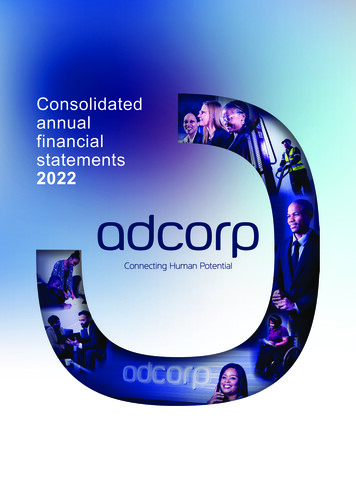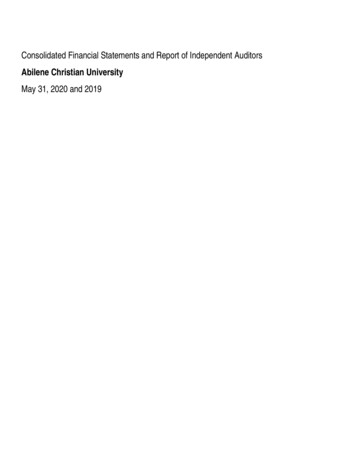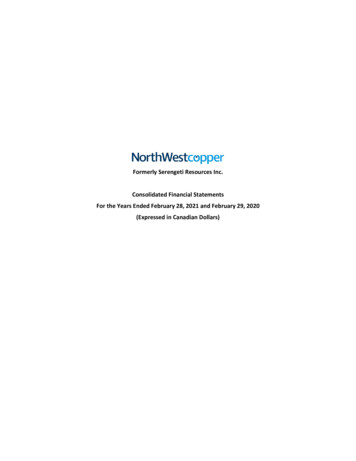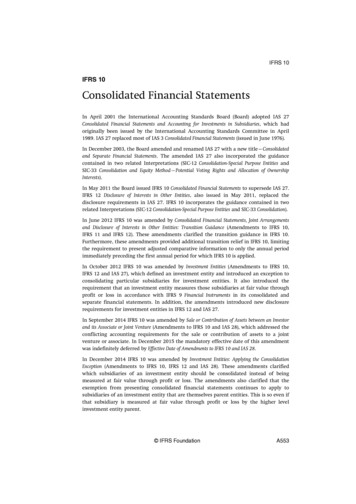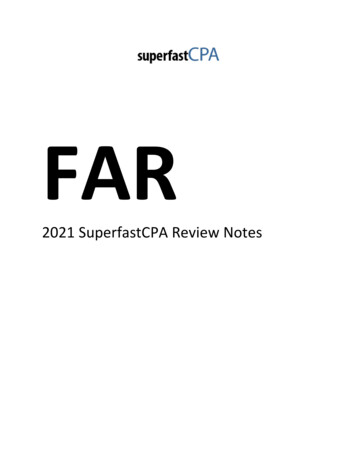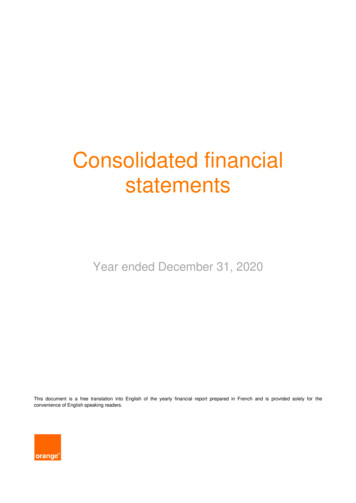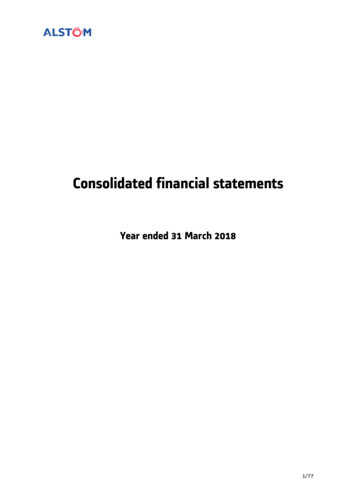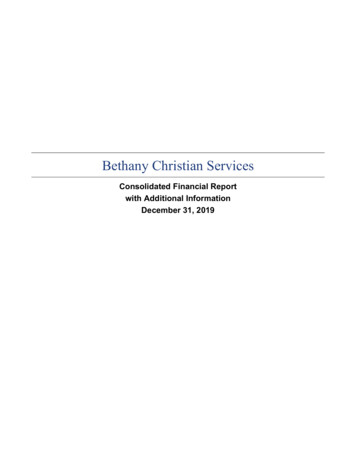
Transcription
Notes to Consolidated Financial StatementsDollars in millions except per share amountsNOTE 1. SUMMARY OF SIGNIFICANT ACCOUNTING POLICIESBasis of Presentation Throughout this document,AT&T Inc. is referred to as “AT&T,” “we” or the “Company.”The consolidated financial statements include the accountsof the Company and our majority-owned subsidiariesand affiliates. Our subsidiaries and affiliates operate inthe communications services industry throughout theU.S. and internationally, providing wireless and wirelinetelecommunications services and equipment as well asdirectory advertising and publishing services.All significant intercompany transactions are eliminated inthe consolidation process. Investments in partnerships, jointventures, and less-than-majority-owned subsidiaries wherewe have significant influence are accounted for underthe equity method. Earnings from certain foreign equityinvestments accounted for using the equity method areincluded for periods ended within up to one month ofour year end (see Note 7).The preparation of financial statements in conformity withU.S. generally accepted accounting principles (GAAP) requiresmanagement to make estimates and assumptions that affectthe amounts reported in the financial statements and accompanying notes, including estimates of probable losses andexpenses. Actual results could differ from those estimates.FAS 160 In December 2007, the Financial AccountingStandards Board (FASB) issued Statement of FinancialAccounting Standards No. 160, “Noncontrolling Interests inConsolidated Financial Statements — an amendment of ARBNo. 51” (FAS 160). FAS 160 requires noncontrolling interestsheld by parties other than the parent in subsidiaries to beclearly identified, labeled, and presented in the consolidatedstatement of financial position within equity, but separatefrom the parent’s equity. FAS 160 is effective for fiscal yearsbeginning after December 15, 2008. At December 31, 2008,we had 375 of noncontrolling interests to be reclassified.FAS 141(R) In December 2007, the FASB issuedStatement of Financial Accounting Standards No. 141 (revised2007), “Business Combinations” (FAS 141(R)). FAS 141(R) is arevision of FAS 141 and requires that costs incurred to effectthe acquisition (i.e., acquisition-related costs) be recognizedseparately from the acquisition. In addition, in accordancewith Statement of Financial Accounting Standards No. 141,“Business Combinations” (FAS 141), restructuring costs thatthe acquirer expected but was not obligated to incur, whichincluded changes to benefit plans, were recognized as if theywere a liability assumed at the acquisition date. FAS 141(R)requires the acquirer to recognize those costs separatelyfrom the business combination. FAS 141(R) is effective forus in 2009, and its impact will vary with each acquisition.FAS 161 In March 2008, the FASB issued Statement ofFinancial Accounting Standards No. 161, “Disclosures aboutDerivative Instruments and Hedging Activities, an amendmentof FASB Statement No. 133” (FAS 161). FAS 161 requiresenhanced disclosures about an entity’s derivative and hedgingactivities to improve the transparency of financial reporting.It is effective for financial statements issued for fiscal yearsand interim periods beginning after November 15, 2008.FAS 161 is expected to increase quarterly and annualdisclosures but will not have an impact on our financialposition and results of operations.FSP 157-3 In October 2008, the FASB issued FASB StaffPosition 157-3, “Determining the Fair Value of a FinancialAsset When the Market of that Asset is not Active” (FSP157-3). FSP 157-3 provides an example that clarifies andreiterates certain provisions of the existing fair value standard,including basing fair value on orderly transactions and usageof management and broker inputs. FSP 157-3 is effectiveimmediately but is not expected to have a material impacton our financial position or results of operations.FSP FAS 142-3 In April 2008, the FASB issued FASB StaffPosition FAS 142-3, “Determination of the Useful Life ofIntangible Assets” (FSP FAS 142-3). FSP FAS 142-3 amendsthe factors that should be considered in developing renewalor extension assumptions used to determine the useful life ofa recognized intangible asset under FASB Statement No. 142,“Goodwill and Other Intangible Assets.” FSP FAS 142-3 iseffective for financial statements issued for fiscal yearsbeginning after December 15, 2008, and interim periodswithin those fiscal years. We are currently evaluating theimpact that FSP FAS 142-3 will have on our accounting forintangible assets.FSP FAS 132(R)-1 In December 2008, the FASB issuedFASB Staff Position FAS 132(R)-1, “Employers’ Disclosuresabout Postretirement Benefit Plan Assets” (FSP FAS 132(R)-1).FSP FAS 132(R)-1 amends FASB Statement No. 132(R),“Employers’ Disclosures about Pensions and OtherPostretirement Benefit” (FAS 132(R)). This FASB Staff Positionreplaces the requirement to disclose the percentage of fairvalue of total plan assets with a requirement to disclose thefair value of each major asset category. It also amendsFASB Statement No. 157, “Fair Value Measurements”(FAS 157), to clarify that defined benefit pension or otherpostretirement plan assets are not subject to FAS 157’sdisclosure requirements. FSP FAS 132(R)-1 is effective forfiscal years ending after December 2009. This FSP willsignificantly increase the amount of disclosures for planassets in our 2009 Annual Report.EITF 08-6 In November 2008, the Emerging Issues TaskForce (EITF) reached a consensus on EITF 08-6, “EquityMethod Investment Accounting Considerations.” EITF 08-6provides guidance on the application of the equity method.It states equity-method investments should be recognizedusing a cost accumulation model. Also, it requires that equitymethod investments as a whole be assessed for otherthan-temporary impairment in accordance with AccountingPrinciples Board Opinion No. 18. EITF 08-6 is effective ona prospective basis for transactions in an investee’s sharesoccurring or impairments recognized in fiscal years, andinterim periods within those fiscal years, beginning on orafter December 15, 2008. This EITF will not have a materialimpact on our financial position and results of operations.AT&T Annual Report 2008 53
Notes to Consolidated Financial Statements (continued)Dollars in millions except per share amountsEITF 08-7 In November 2008, the EITF reached aconsensus on EITF 08-7, “Accounting for Defensive IntangibleAssets.” EITF 08-7 provides that intangible assets that anacquirer intends to use as defensive assets, intangible assetsacquired in a business combination or an asset acquisitionthat an entity does not intend to actively use but does intendto prevent others from using, are a separate unit of accountfrom the existing intangible assets of the acquirer. It also statesthat a defensive intangible asset should be amortized overthe period that the fair value of the defensive intangible assetdiminishes. EITF 08-7 is effective on a prospective basis fortransactions occurring in fiscal years, and interim periods withinthose fiscal years, beginning on or after December 15, 2008.This EITF will require AT&T to recognize at fair value certainassets associated with trademarks for the non-survivingcompanies of acquisitions and amortize these trademarksover the period they are expected to contribute directly orindirectly to the entity’s future cash flows.Valuation and Other Adjustments Included in the currentliabilities reported on our consolidated balance sheet areaccruals established under EITF 95-3, “Recognition of Liabilitiesin Connection with a Purchase Business Combination” (EITF95-3). The liabilities include accruals for severance, leaseterminations and equipment removal costs associated with ouracquisitions of AT&T Corp., BellSouth Corporation (BellSouth)and Dobson Communications Corporation. Following is asummary of the accruals recorded under EITF 95-3 atDecember 31, 2007, cash payments made during 2008 andthe adjustments thereto.12/31/07BalanceSeverance accrualspaid from:Company fundsPension andpostemploymentbenefit plansLease terminationsEquipment removaland otherrelated costsTotalCashPaymentsAdjustmentsand Accruals12/31/08Balance 540 (321) (79) 140129425(26)(110)—72103387161 1,255(62) (519)(11) (18)88 718Split-Dollar Life Insurance In 2007, the EITF ratifiedthe consensus on EITF 06-4, “Accounting for DeferredCompensation and Postretirement Benefit Aspects ofEndorsement Split-Dollar Life Insurance Arrangements”(EITF 06-4) and EITF 06-10 “Accounting for CollateralAssignment Split-Dollar Life Insurance Arrangements”(EITF 06-10). EITF 06-4 and EITF 06-10 cover split-dollarlife insurance arrangements (where the company owns andcontrols the policy) and provides that an employer shouldrecognize a liability for future benefits in accordance withStatement of Financial Accounting Standards No. 106,“Employers’ Accounting for Postretirement Benefits Other54 AT&T Annual Report 2008Than Pensions” (FAS 106). These are effective for fiscal yearsbeginning after December 15, 2007. We adopted EITF 06-4and EITF 06-10 on January 1, 2008, recording additionalpostretirement liabilities of 101 and a decrease to retainedearnings of 63.Reclassifications We have reclassified certain amountsin prior-period financial statements to conform to the currentperiod’s presentation.Income Taxes We adopted Financial AccountingStandards Board Interpretation No. 48 “Accounting forUncertainty in Income Taxes” (FIN 48) on January 1, 2007.With our adoption of FIN 48, we provide deferred incometaxes for temporary differences between the carryingamounts of assets and liabilities for financial reportingpurposes and the tax basis of assets and liabilitiescomputed pursuant to FIN 48. Under FIN 48, the tax basesof assets and liabilities are based on amounts that meetthe FIN 48 recognition threshold and are measuredpursuant to the measurement requirement in FIN 48.To the extent allowed by GAAP, we provide valuationallowances against the deferred tax assets for which therealization is uncertain. We review these items regularlyin light of changes in federal and state tax laws andchanges in our business.Investment tax credits earned prior to their repeal by theTax Reform Act of 1986 are amortized as reductions in incometax expense over the lives of the assets, which gave rise tothe credits. Additionally, we report taxes imposed by governmental authorities on revenue-producing transactions betweenus and our customers in the income statement on a net basis.Cash Equivalents Cash and cash equivalents include allhighly-liquid investments with original maturities of threemonths or less and the carrying amounts’ approximate fairvalue. At December 31, 2008, we held 958 in cash and 834 in money market funds and other cash equivalents.Investment Securities Investments in securities principallyconsist of available-for-sale instruments. Short-term andlong-term investments in money market securities are carried asheld-to-maturity securities. Available-for-sale securities consistof various debt and equity securities that are long term innature. Unrealized gains and losses, net of tax, on availablefor-sale securities are recorded in accumulated other comprehensive income. Our investment securities maturing withinone year are recorded in “Other current assets” and instrumentswith maturities of more than one year are recorded in “OtherAssets” on the consolidated balance sheets. Unrealized lossesthat are considered other than temporary are recorded in OtherIncome (Expense) with the corresponding reduction to thecarrying basis of the investment (see Note 11).Statement of Financial Accounting Standards No. 157,“Fair Value Measurements” (FAS 157) requires disclosures forfinancial assets and liabilities that are remeasured at fair valueat least annually. FAS 157 establishes a three-tier fair valuehierarchy, which prioritizes the inputs used in measuring fairvalue. These tiers include: Level 1, defined as observableinputs such as quoted prices in active markets; Level 2,
defined as inputs other than quoted prices in active marketsthat are either directly or indirectly observable; and Level 3,defined as unobservable inputs in which little or no marketdata exists, therefore requiring an entity to develop its ownassumptions. Substantially all of our available-for-salesecurities are valued using quoted market prices (referredto as Level 1). Adjustments to fair value are recorded inother comprehensive income until the investment is soldor they are impaired (see Note 2). The fair market valueof these securities was 1,632 at December 31, 2008.Revenue Recognition Revenues derived from wireless,local telephone, long-distance, data and video services arerecognized when services are provided. This is based uponeither usage (e.g., minutes of traffic processed), period of time(e.g., monthly service fees) or other established fee schedules.Our wireless service revenues are billed either in advance,arrears or are prepaid. Our wireless Rollover rate plans includea feature whereby unused anytime minutes do not expire eachmonth but rather are available, under certain conditions, forfuture use for a period not to exceed one year from the dateof purchase. Using historical subscriber usage patterns, wedefer these revenues based on an estimate of the portion ofunused minutes expected to be utilized prior to expiration.We record an estimated revenue reduction for futureadjustments to customer accounts, other than a provision fordoubtful accounts, at the time revenue is recognized based onhistorical experience. Service revenues also include billings toour customers for various regulatory fees imposed on us bygovernmental authorities. Cash incentives given to customersare recorded as a reduction of revenue. When required as partof providing service, revenues and associated expenses relatedto nonrefundable, upfront service activation and setup feesare deferred and recognized over the associated servicecontract period. If no service contract exists, those fees arerecognized over the average customer relationship period.Associated expenses are deferred only to the extent of suchdeferred revenue. For contracts that involve the bundling ofservices, revenue is allocated to the services based on theirrelative fair value. We record the sale of equipment tocustomers as gross revenue when we are the primary obligorin the arrangement, when title is passed and when theproducts are accepted by customers. For agreements involvingthe resale of third-party services in which we are notconsidered the primary obligor of the arrangement, werecord the revenue net of the associated costs incurred.For contracts in which we provide customers with anindefeasible right to use network capacity, we recognizerevenue ratably over the stated life of the agreement.We recognize revenues and expenses related to publishingdirectories on the amortization method, which recognizesrevenues and expenses ratably over the life of the directorytitle, typically 12 months.Traffic Compensation Expense We use various estimatesand assumptions to determine the amount of traffic compensation expenses recognized during any reporting period.Switched traffic compensation costs are accrued utilizingestimated rates by product, formulated from historical dataand adjusted for known rate changes and volume levels.Such estimates are adjusted monthly to reflect newlyavailable information, such as rate changes and new contractual agreements. Bills reflecting actual incurred informationare generally not received until three to nine monthssubsequent to the end of the reporting period, at whichpoint a final adjustment is made to the accrued switchedtraffic compensation expense. Dedicated traffic compensationcosts are estimated based on the number of circuits andthe average projected circuit costs. These costs are adjustedto reflect actual expenses over the three months followingthe end of the reporting period as bills are received.Allowance for Uncollectibles We maintain an allowancefor doubtful accounts for estimated losses that result fromthe failure or inability of our customers to make requiredpayments. When determining the allowance, we consider theprobability of recoverability of accounts receivable based onpast experience, taking into account current collection trendsas well as general economic factors, including bankruptcyrates. Credit risks are assessed based on historical write-offs,net of recoveries, as well as an analysis of the aged accountsreceivable balances with reserves generally increasing as thereceivable ages. Accounts receivable may be fully reservedfor when specific collection issues are known to exist, suchas pending bankruptcy or catastrophes. The analysis ofreceivables is performed monthly and the bad-debt allowances are adjusted accordingly.Inventory Inventories are included in “Other currentassets” on our consolidated balance sheet and were 862 and 1,119 at December 31, 2008 and 2007, respectively. Wirelesshandsets and accessories, which are valued at the lower ofcost or market value (determined using current replacementcost) amount to 749 and 836 for the years 2008 and 2007.The remainder of our inventory includes new and reusablesupplies and network equipment of our local telephoneoperations, which are stated principally at average originalcost, except that specific costs are used in the case of largeindividual items. Inventories of our other subsidiaries arestated at the lower of cost or market.Property, Plant and Equipment Property, plant andequipment is stated at cost, except for assets acquired usingpurchase accounting, which are recorded at fair value (seeNote 2). The cost of additions and substantial improvementsto property, plant and equipment is capitalized. The cost ofmaintenance and repairs of property, plant and equipment ischarged to operating expenses. Property, plant and equipmentis depreciated using straight-line methods over their estimatedeconomic lives. Certain subsidiaries follow composite groupAT&T Annual Report 2008 55
Notes to Consolidated Financial Statements (continued)Dollars in millions except per share amountsdepreciation methodology; accordingly, when a portion oftheir depreciable property, plant and equipment is retiredin the ordinary course of business, the gross book value isreclassified to accumulated depreciation; no gain or loss isrecognized on the disposition of this plant.Property, plant and equipment is reviewed for recoverabilitywhenever events or changes in circumstances indicate thatthe carrying amount may not be recoverable. An impairmentloss shall be recognized only if the carrying amount of along-lived asset is not recoverable and exceeds its fair value.The carrying amount of a long-lived asset is not recoverableif it exceeds the sum of the undiscounted cash flows expectedto result from the use and eventual disposition of the asset.The fair value of a liability for an asset retirementobligation is recorded in the period in which it is incurredif a reasonable estimate of fair value can be made. In periodssubsequent to initial measurement, period-to-period changesin the liability for an asset retirement obligation resultingfrom the passage of time and revisions to either the timingor the amount of the original estimate of undiscounted cashflows are recognized. The increase in the carrying value ofthe associated long-lived asset is depreciated over thecorresponding estimated economic life.Software Costs It is our policy to capitalize certain costsincurred in connection with developing or obtaining internaluse software. Capitalized software costs are included in“Property, Plant and Equipment” on our consolidated balancesheets and are primarily amortized over a three-year period.Software costs that do not meet capitalization criteria areexpensed immediately.Goodwill and Other Intangible Assets Goodwill representsthe excess of consideration paid over the fair value of netassets acquired in business combinations. Goodwill and otherindefinite-lived intangible assets are not amortized but aretested at least annually for impairment. We have completedour annual impairment testing for 2008 and determinedthat no impairment exists.Intangible assets that have finite useful lives are amortizedover their useful lives, a weighted average of 7.4 years.Customer relationships are amortized using primarily thesum-of-the-months-digits method of amortization over theexpected period in which those relationships are expected tocontribute to our future cash flows based in such a way as toallocate it as equitably as possible to periods during which weexpect to benefit from those relationships.A significant portion of intangible assets in our wirelesssegment are Federal Communications Commission (FCC)licenses that provide us with the exclusive right to utilize certainradio frequency spectrum to provide wireless communicationsservices. While FCC licenses are issued for a fixed time, renewalsof FCC licenses have occurred routinely and at nominal cost.Moreover, we have determined that there are currently no legal,regulatory, contractual, competitive, economic or other factorsthat limit the useful lives of our FCC licenses, and thereforethe FCC licenses are an indefinite-lived intangible asset underthe provisions of Statement of Financial Accounting StandardsNo. 142, “Goodwill and Other Intangible Assets.”56 AT&T Annual Report 2008In accordance with EITF No. 02-7, “Unit of Accountingfor Testing Impairment of Indefinite-Lived Intangible Assets,”we test FCC licenses for impairment on an aggregate basis,consistent with the management of the business on a nationalscope. During the fourth quarter of 2008, we completedthe annual impairment tests for indefinite-lived FCC licenses.These annual impairment tests resulted in no impairmentof indefinite-lived FCC licenses.Advertising Costs Advertising costs for advertisingproducts and services or for promoting our corporate imageare expensed as incurred.Foreign Currency Translation Our foreign investmentsand foreign subsidiaries generally report their earnings intheir local currencies. We translate our share of their foreignassets and liabilities at exchange rates in effect at the balancesheet dates. We translate our share of their revenues andexpenses using average rates during the year. The resultingforeign currency translation adjustments are recorded as aseparate component of accumulated other comprehensiveincome in the accompanying consolidated balance sheets.Gains and losses resulting from exchange-rate changes ontransactions denominated in a currency other than the localcurrency are included in earnings as incurred.We have also entered into foreign currency contracts tominimize our exposure to risk of adverse changes in currencyexchange rates. We are subject to foreign exchange risk forforeign currency-denominated transactions, such as debtissued, recognized payables and receivables and forecastedtransactions. At December 31, 2008, our foreign currencyexposures were principally Mexican pesos, Euros, Danishkrone, Swedish krona and Canadian dollars.Derivative Financial Instruments We record derivativeson the balance sheet at fair value. We do not invest inderivatives for trading purposes. We use derivatives fromtime to time as part of our strategy to manage risksassociated with our contractual commitments. Thesederivatives are designated as either a hedge of the fairvalue of a recognized asset or liability or of an unrecognizedfirm commitment (fair value hedge), or a hedge of aforecasted transaction or of the variability of cash flowsto be received or paid related to a recognized assetor liability (cash flow hedge). Our derivative financialinstruments primarily include interest rate swap agreementsand foreign currency exchange contracts. For example,we use interest rate swaps to manage our exposure tochanges in interest rates on our debt obligations (seeNote 9). We account for our interest rate swaps usingmark-to-market accounting and include gains or lossesfrom interest rate swaps when paid or received in interestexpense in our consolidated statements of income.Amounts paid or received on interest rate forwardcontracts are amortized over the period of the relatedinterest payments.All other derivatives are not formally designated foraccounting purposes (undesignated). These derivatives,although undesignated for accounting purposes, are enteredinto to hedge economic risks.
We record changes in the fair value of fair value hedges,along with the changes in the fair value of the hedgedasset or liability that is attributable to the hedged risk.Gains or losses upon termination of our fair value hedgesare recognized as interest expense when the hedgeinstrument is settled.We record changes in the fair value of cash flow hedges,along with the changes in the fair value of the hedgedasset or liability that is attributable to the hedged risk, in“Accumulated other comprehensive income,” which is acomponent of Stockholders’ Equity. This includes the foreigncurrency contracts noted above. The settlement gains orcosts on our cash flow hedges are amortized as interestexpense over the term of the interest payments of therelated debt issuances.Changes in the fair value of undesignated derivatives arerecorded in other income (expense), net, along with the changein fair value of the underlying asset or liability, as applicable.Cash flows associated with derivative instruments arepresented in the same category on the consolidatedstatements of cash flows as the item being hedged.When hedge accounting is discontinued, the derivative isadjusted for changes in fair value through other income(expense), net. For fair value hedges, the underlying asset orliability will no longer be adjusted for changes in fair value,and any asset or liability recorded in connection with thehedging relationship (including firm commitments) will beremoved from the balance sheet and recorded in currentperiod earnings. For cash flow hedges, gains and lossesthat were accumulated in other comprehensive income asa component of stockholders’ equity in connection withhedged assets or liabilities or forecasted transactions willbe recognized in other income (expense) – net, in the sameperiod the hedged item affects earnings.Employee Separations In accordance with Statementof Financial Accounting Standards No. 112, “Employers’Accounting for Postemployment Benefits,” (FAS 112) weestablish obligations for expected termination benefitsprovided under existing plans to former or inactive employeesafter employment but before retirement. These benefitsinclude severance payments, workers’ compensation,disability, medical continuation coverage and other benefits.At December 31, 2008, we had severance accruals underFAS 112 of 752. At December 31, 2007, we had severanceaccruals of 127.Pension and Postretirement Benefits See Note 11 for acomprehensive discussion of our pension and postretirementbenefit expense, including a discussion of the actuarialassumptions.NOTE 2. A CQUISITIONS, DISPOSITIONS, VALUATION ANDOTHER ADJUSTMENTSAcquisitionsDobson In November 2007, we acquired DobsonCommunications Corporation (Dobson) for approximately 2,500. Under the purchase method of accounting, thetransaction was valued, for accounting purposes, at 2,580.Our December 31, 2007 consolidated balance sheet includedthe preliminary valuation of the fair value of Dobson’s assetsand liabilities, including goodwill of 2,623, licenses of 2,230,customer lists of 517 and other intangible assets totaling 8associated with this transaction. Final adjustments to thepreliminary valuation included an increase to goodwill of 990,a decrease in licenses of 781 and a decrease in customerlists of 12. The resulting balances are 3,613 for goodwill, 1,449 for licenses and 505 for customer lists. Adjustmentswere primarily related to changes in the valuation of certainlicenses and an increase in the estimate of relativeobsolescence of property, plant and equipment resulting ina decrease in value and shorter average remaining economiclife, and an adjustment to the value of the markets includedin the divestiture order by the FCC. Pursuant to the order, weexchanged certain properties, spectrum and 355 in cash forother licenses and properties. Deferred tax adjustments areassociated with the above-mentioned items. Dobson marketedwireless services under the Cellular One brand and hadprovided roaming services to AT&T subsidiaries since 1990.Dobson had 1.7 million subscribers across 17 states. Dobson’soperations were incorporated into our wireless operationsfollowing the date of acquisition.BellSouth Corporation In December 2006, we acquiredBellSouth under FAS 141, issuing 2.4 billion shares.BellSouth was the leading communications service providerin the southeastern U.S., providing wireline communicationsservices, including local exchange, network access, longdistance services and Internet services to substantialportions of the population across nine states. BellSouthalso provided long-distance services to enterprise customersthroughout the country.We and BellSouth jointly owned AT&T Mobility and theInternet-based publisher YELLOWPAGES.COM (YPC). In theAT&T Mobility joint venture, we held a 60% economic interestand BellSouth held a 40% economic interest, and in the YPCjoint venture, we held a 66% economic interest and BellSouthheld a 34% economic interest. For each joint venture, controlwas shared equally. We and BellSouth each accounted forthe joint ventures under the equity method of accounting,recording the proportional share of AT&T Mobility’s andYPC’s income as equity in net income of affiliates on theAT&T Annual Report 2008 57
Notes to Consolidated Financial Statements (continued)Dollars in millions except per share amountsrespective consolidated statements of income and reportingthe own
Statement of Financial Accounting Standards No. 141 (revised 2007), "Business Combinations" (FAS 141(R)). FAS 141(R) is a revision of FAS 141 and requires that costs incurred to effect . Asset When the Market of that Asset is not Active" (FSP 157-3). FSP 157-3 provides an example that clarifies and

